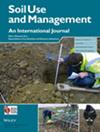Effects of poly‐γ‐glutamic acid addition on the transformation and distribution of soil nitrogen under different water conditions
IF 3.7
3区 农林科学
Q1 SOIL SCIENCE
引用次数: 0
Abstract
The impact of external poly‐γ‐glutamic acid (γ‐PGA) on soil nitrogen (N) transformation and distribution remains unclear, despite its contrasting effects on N use efficiency. Therefore, soil culture and soil column experiments were conducted using three different γ‐PGA addition rates (0%, 4% and 8% of dry soil weight, w/w) under different soil water contents (40%, 60% and 80% of field water capacity) and dry–wet cycles (0, 2, 4 and 8 times cycles; a single dry–wet cycle involved reducing soil water content from 80% to 40% of field water capacity) in sandy loam soil. The results of soil culture experiment showed that the γ‐PGA significantly increased soil –N and –N contents, as well as nitrification and transformation rates. However, these effects were observed to be influenced by both the culture time and soil water content. In addition, the results of soil column experiment showed that γ‐PGA not only significantly enhanced the soil inorganic nitrogen content within the 0–20 cm soil layer, but also improved water retention capacity. However, the differences between the γ‐PGA treatments gradually diminished with an increase in dry–wet cycle times. These results indicate that γ‐PGA addition enhanced soil inorganic N content and soil water retention by influencing soil N transformation and water distribution. However, the impact of γ‐PGA addition on soil improvement was regulated by soil water content, which should be taken into full consideration in agricultural practices.添加聚γ-谷氨酸对不同水分条件下土壤氮的转化和分布的影响
外部聚γ-谷氨酸(γ-PGA)对土壤氮(N)转化和分布的影响仍不清楚,尽管其对氮利用效率的影响截然不同。因此,在不同土壤含水量(田间持水量的 40%、60% 和 80%)和干湿循环(0、2、4 和 8 次循环;单次干湿循环包括将土壤含水量从田间持水量的 80% 降至 40%)条件下,采用三种不同的 γ-PGA 添加率(土壤干重的 0%、4% 和 8%,w/w)在砂壤土中进行了土壤培养和土壤柱实验。土壤培养实验结果表明,γ-PGA 能显著提高土壤中的氮和氮含量,以及硝化和转化率。然而,这些效果受培养时间和土壤含水量的影响。此外,土柱实验结果表明,γ-PGA 不仅能显著提高 0-20 cm 土层内的土壤无机氮含量,还能提高土壤的保水能力。然而,随着干湿循环时间的增加,γ-PGA 处理之间的差异逐渐减小。这些结果表明,γ-PGA 的添加通过影响土壤氮的转化和水分分布,提高了土壤无机氮含量和土壤保水能力。然而,添加γ-PGA 对土壤改良的影响受土壤含水量的调节,这一点在农业实践中应充分考虑。
本文章由计算机程序翻译,如有差异,请以英文原文为准。
求助全文
约1分钟内获得全文
求助全文
来源期刊

Soil Use and Management
农林科学-土壤科学
CiteScore
7.70
自引率
13.20%
发文量
78
审稿时长
3 months
期刊介绍:
Soil Use and Management publishes in soil science, earth and environmental science, agricultural science, and engineering fields. The submitted papers should consider the underlying mechanisms governing the natural and anthropogenic processes which affect soil systems, and should inform policy makers and/or practitioners on the sustainable use and management of soil resources. Interdisciplinary studies, e.g. linking soil with climate change, biodiversity, global health, and the UN’s sustainable development goals, with strong novelty, wide implications, and unexpected outcomes are welcomed.
 求助内容:
求助内容: 应助结果提醒方式:
应助结果提醒方式:


